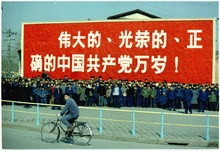Propaganda in the People's Republic of China
| Propaganda in the People's Republic of China | |||||||

Large sign featuring a propaganda slogan in 1972: "Long Live the Great, Glorious, and Correct Communist Party!"
|
|||||||
| Simplified Chinese | 中华人民共和国宣传活动 | ||||||
|---|---|---|---|---|---|---|---|
| Traditional Chinese | 中華人民共和國宣傳活動 | ||||||
|
|||||||
| Transcriptions | |
|---|---|
| Standard Mandarin | |
| Hanyu Pinyin | Zhōnghuá rénmín gònghéguó xuānchuán huódòng |
Propaganda in the People's Republic of China refers to the use of propaganda by the Communist Party of China to sway public and international opinion in favor of its policies. Domestically, this includes censorship of proscribed views and an active cultivation of views that favor the government. Propaganda is considered central to the operation of the CPC government. The common Chinese term xuānchuán (宣传) can mean "dissemination", "propaganda", or "publicity".
Aspects of propaganda can be traced back to the earliest periods of Chinese history, but propaganda has been most effective in the twentieth century owing to mass media and an authoritarian government. China in the era of Mao Zedong is known for its constant use of mass campaigns to legitimize the state and the policies of leaders. It was the first CPC to successfully make use of modern mass propaganda techniques, adapting them to the needs of a country which had a largely rural and illiterate population.
Today, propaganda in China is usually depicted through cultivation of the economy and Chinese nationalism.
The origins of the CPC propaganda system can be traced to Yan'an Rectification Movement and the rectification movements carried out there. following which it became a key mechanism in the Party's campaigns. Mao explicitly laid out the political role of culture in his 1942 "Talks at the Yan'an Forum on Art and Literature". The propaganda system, considered a central part of CCP's "control system", drew much from Soviet, Nazi and other totalitarian states' propaganda methods. It represented a quintessential Leninist "transmission belt" for indoctrination and mass mobilization. David Shambaugh observes that propaganda and indoctrination are considered to have been a hallmark of the Maoist China; the CCP employed a variety of "thought control" techniques, including incarceration for "thought reform," construction of role models to be emulated, mass mobilization campaigns, the creation of ideological monitors and propaganda teams for indoctrination purposes, enactment of articles to be memorized, control of the educational system and media, a nationwide system of loudspeakers, among other methods. While ostensibly aspiring to a "Communist utopia," often had a negative focus on constantly searching for enemies among the people. The means of persuasion was often extremely violent, "a literal acting out of class struggle."
...
Wikipedia
